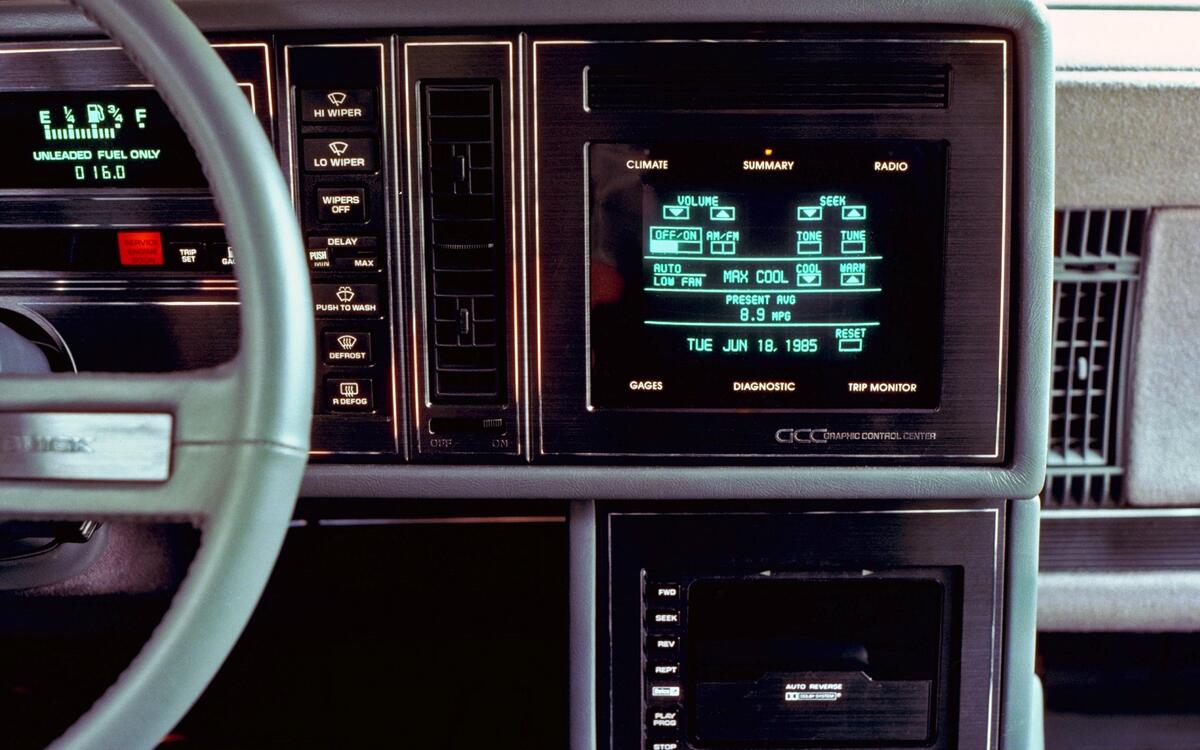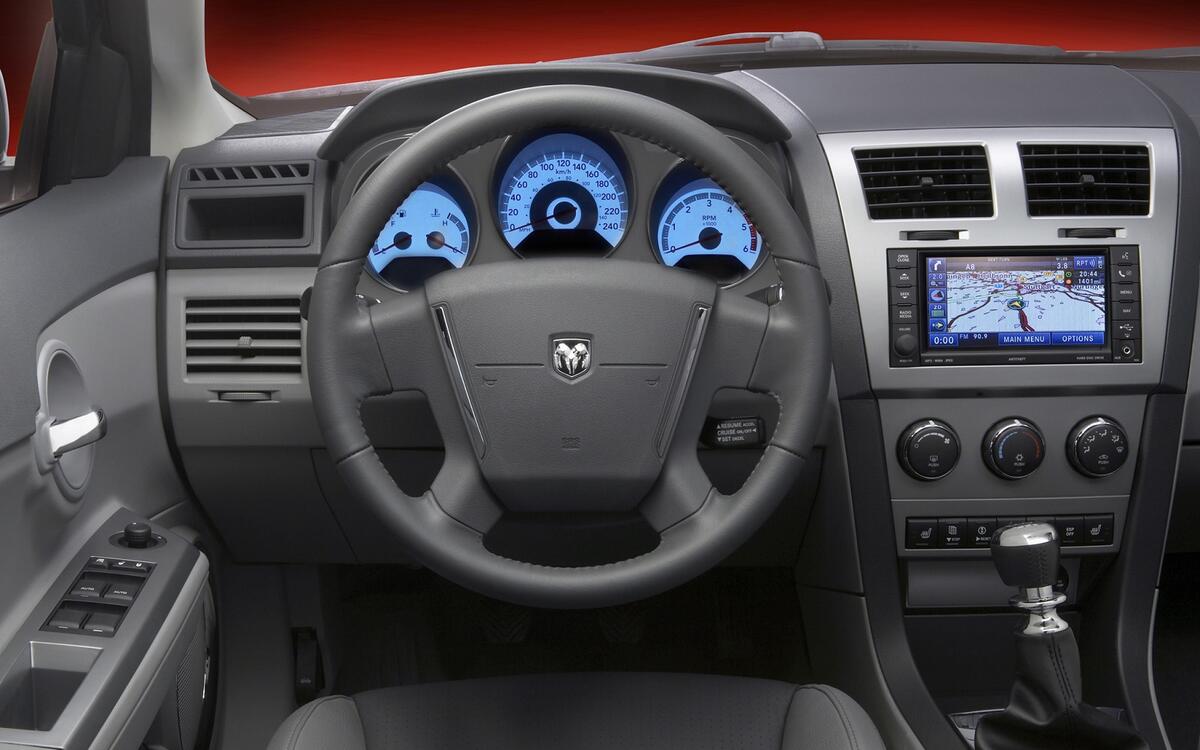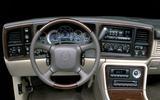 Slide of
Slide of
Following the interior design of American cars is akin to going on a styling roller coaster.
There were periods in which stylists from the major car brands let their imagination run wild followed by long periods of noticeable restraint. The same can be said about exterior design and, overall, the way a car looks reflects what buyers ask for during that specific era.
In hindsight, the wilder stages were largely influenced by technology – or, at least, the promise of it. Some of the most outlandish dashboards came to life when automakers began adding computers to their cars. Looking only at production models, here are some of the most unusual dashboard designs American automakers have released since the 1950s:
 Slide of
Slide of
Chevrolet Corvette (1953)
Concept car-like styling, not power, was the original Chevrolet Corvette’s main selling point. The futuristic design of the body continued inside with a dashboard that was almost symmetrical. Stylists hid a speaker in a part of the dashboard shaped almost exactly like the speedometer. They also arranged six gauges horizontally on the bottom part of the dashboard and placed the ignition on the left of the cluster to maintain continuity.
At the time, owners joked the passenger got a better view of the rev-counter (which was mounted right in the middle of the dashboard) than the driver.
 Slide of
Slide of
Imperial Crown (1960)
Chrysler’s flagship Imperial division wanted its buyers to feel like they were living in the jet age when it restyled the Crown in 1960. Designers mounted a pair of turbine-inspired gauges illuminated by electroluminescent lighting behind an oval steering wheel and added a vertical row of buttons on either side of the instrument cluster. The ones on the left let the driver put the automatic transmission in gear; the ones on the right were linked to the climate control system.
Imperial offered an automatic, power-operated swivel seat for $121 (about $1,000 in 2019 money).
 Slide of
Slide of
Mercury Cougar (1967)
Mercury seemingly ran out of real estate when it styled the Cougar’s interior. It installed a pair of relatively big analog guages behind a steering wheel with an oversized hub and scattered five additional guages (including a clock) across the rest of the dashboard. Oddly, the oil pressure guage ended up on the passenger side of the dashboard.
All told, the Cougar’s cockpit looked more like something you’d expect to find in a boat than in a performance-oriented coupe. The Ford Mustang that the Cougar was based on received a similar design during the late 1960s.
 Slide of
Slide of
Oldsmobile 98 (1970)
In 1970, the Oldsmobile 98’s dashboard featured four pods that were, intentionally or not, shaped a lot like its four headlights. That’s not a design feature we’ve seen on many cars regardless of when or where it was built.
The pods housed the usual assortment of gauges, like the speedometer, and the driver looked at them through a steering wheel with three spokes arranged in a T shape.
 Slide of
Slide of
Cadillac Coupe DeVille (1971)
Cadillac likely isn’t the brand that comes to mind when you think of a driver-oriented dashboard, but the 1971 Coupe DeVille adopted a layout that made drivers feel like they were sitting front and center. Designers integrated the speedometer, the radio and a handful of switches into a panel angled towards the driver’s seat.
The wiper controls were mounted on the door panel. Sister company Oldsmobile briefly adopted a similar driver-focused design during the early 1970s, notably on the Toronado.
 Slide of
Slide of
Ford Thunderbird (1980)
Largely forgotten about in 2019, the eighth-generation Ford Thunderbird represented a cursory attempt at future-proofing the emblematic nameplate. It was shorter than its predecessors because it sat on the Fox platform also found under the Mustang and it became the first Thunderbird offered with a six-cylinder engine. The unit in question was an 88hp 3.3-liter straight-six.
Ford hoped the tech of the future would help buyers forget the six's measly output. While entry-level cars received regular analog gauges, the firm offered an electronic instrument cluster with a digital speedometer and fuel gauge at an extra cost. Pricing varied between $275 and $313 (about $850 and $960, respectively in 2019 money) depending on the variant. Buyers could also pay $316 for a CB radio, the 'social media' craze of the time.
The Thunderbird-derived Mercury Cougar offered the same electronic instrument cluster. Both models retired after the 1982 model year but Ford wasn’t done dabbling in digital gauges...
 Slide of
Slide of
Cadillac Cimarron (1982)
Often remembered as one of Cadillac’s most prodigious failures, the Cimarron was aimed directly at European imports like the BMW 3 Series and the Saab 900. It consequently had to feel sportier than the firm’s other models to remain credible but Cadillac’s creativity well ran dry when it began designing the interior.
The Cimarron plainly shared many of its interior parts with the Chevrolet Cavalier it was quite obviously based on. Worse yet, it used the same Playmobil-grade plastics. The Cimarron’s interior layout was unusual for a Cadillac, and it contributed to the model's collapse.
 Slide of
Slide of
Chevrolet Camaro Berlinetta (1982)
Digitalization was the name of the game during the 1980s. Chevrolet fitted the Camaro Berlinetta with digital gauges for the speedometer and the tachometer, kept analog gauges for the fuel level and the temperature, among other functions, and added a cluster of warning lights on the right side of the cluster.
Dozens of buttons that would make a Texas Instrument calculator green with envy were placed at the driver’s fingertips. Sitting in the Berlinetta felt like commanding a space ship.
 Slide of
Slide of
Ford Thunderbird (1983)
For Ford, upscale already meant high-tech at the beginning of the 1980s. The company offered some variants of the ninth-generation Thunderbird (including, ironically, the Heritage trim) with an electronic instrument cluster that included a rev-counter, a speedometer plus information like real-time fuel economy and the average speed. Well-equipped cars came with a multi-function steering wheel, a digital read-out for the climate control and a stereo with an equalizer.
Air vents unfortunately shaped like something you’d buy from a waffle vendor in a picturesque part of Belgium broke the upscale ambiance, however. The sixth-generation Mercury Cougar was closely related to the Thunderbird so buyers could upgrade it with a similarly digital interior.
 Slide of
Slide of
Chevrolet Corvette (1984)
The fourth-generation Chevrolet Corvette launched with a dashboard that looked like it was chiseled from a solid block of hard, black plastic. Its instrument cluster included two speedometers. The first gave a digital read-out of the speed; the second indicated speed with digital bars. The American law that forced automakers to cap speedometers at 85mph was repealed in 1981 but many automakers (including Chevrolet) followed it for several more years.
Stylists integrated the stereo, the climate control units, the warning lights and a small cluster of buttons into a series of squares positioned on the center console. Luckily, buyers who wanted a touch of color inside their Corvette could order the carpet and the upholstery in red or blue, among other shades.
 Slide of
Slide of
Buick Riviera (1986)
The smaller dimensions were merely the tip of the iceberg for the 1986 Buick Riviera. Inside, it gained a touch-sensitive, 9in screen that displayed a primitive yet highly innovative infotainment system named Graphic Control Center (GCC) which replaced 91 controls, according to Buick. The driver could poke the screen to change the radio station, adjust the temperature and access vehicle diagnostic information.
Powered by a pair of eight-bit processors, the GCC technology evolved and it later spread to Buick’s Reatta before disappearing in 1990. Oldsmobile used it, too. Customers complained that taking their eyes off the road to poke a screen in order to raise the temperature in the cabin was distracting - it also issued a loud bleep at every touch. We can’t help but wonder how they’re getting on with modern cars in 2019.
 Slide of
Slide of
Cadillac Allanté (1986)
Cadillac went full-fighter jet when it designed the Pininfarina-built Allanté’s interior. Sitting on a Recaro-designed seat, the driver faced a pair of round analog gauges with a digital speed read-out and dozens of buttons positioned below and on the right of the instrument cluster.
The crosshairs in the middle of the gauges almost looked like they came from a video game. The Allanté didn’t come with homing missiles but buyers could add more tech to the cabin by ordering an in-car cellular phone.
 Slide of
Slide of
Pontiac Bonneville SSE (1988)
Pontiac daringly re-invented the Bonneville as a smaller, front-wheel drive car in 1987. The range-topping SSE model added to the line-up in 1988 received several digital screens on the dashboard but its steering wheel was the real show-stopper. Engineers stuffed nine buttons in the middle of it to let the driver control the radio and adjust the temperature while keeping both hands on the wheel. The designed looked like it was straight out of a concept car. Nine additional buttons grouped in a cluster positioned on the center console let the front occupants adjust their seats.
The 6000 STE received a similar steering wheel with 12 buttons. Airbag regulations forced Pontiac to adopt a more compact, less science ficiton-like version of the multi-function steering wheel in the early 1990s.
 Slide of
Slide of
Lincoln Town Car (1990)
The Lincoln Town car experienced an identity crisis during the 1990s. On the outside, it was a body-on-frame behemoth that was firmly anchored to tradition. On the inside, it moved in a more daring direction with a curved dashboard, an available cellular phone and a digital instrument cluster. Lincoln applied the alarm clock-like design to the speedometer, the tachometer and the fuel gauge, among other functions. The look didn’t catch buyers off-guard because the previous Town Car had gone digital, too.
Lincoln replaced the digital instrument cluster with analog gauges in 1991 but it brought the feature back as an optional extra in 1992 and made it standard again in 1993. The new Town Car introduced in 1998 returned to analog gauges, though Lincoln kept screens on either side of the speedometer.
 Slide of
Slide of
Hummer H1 (1992)
Designers did precious little to hide the Hummer H1’s military roots. The truck was wide enough to accommodate at least eight passengers but it only had four seats – and one of the widest dashboards ever fitted to a production car.
Early models were incredibly basic in spite of their relatively high price tag but Hummer took the H1 upmarket over the course of the 1990s by making it nicer inside and adding features. The tall, wide dashboard remained throughout its entire production run.
 Slide of
Slide of
Chrysler PT Cruiser (2000)
Many Chrysler products received a similar-looking interior in the 1990s. With few exceptions, the designs were characterized by various oval shapes and a generous serving of fake wood trim. The PT Cruiser – which started life as a Plymouth – broke all ties with other Chrysler models by going in a more retro direction that suited its exterior styling well.
Its upright center stack was almost SUV-like and the driver looked at four analog gauges arranged in three separate pods behind a four-spoke steering wheel.
 Slide of
Slide of
Panoz Esperante (2000)
Georgia-based automaker Panoz rummaged through the Ford parts bin to build the Esperante. It featured a 305hp, 4.6-liter V8 (which went through the hands of Elan Motorsports Technologies before entering the Esperante’s engine bay) and an analog instrument cluster sourced from the Mustang.
Panoz placed the gauges in the middle of the dashboard, a layout which created an unusually tall center console that was, for better or worse, directly in the passengers' line of sight.
 Slide of
Slide of
Cadillac Escalade (2001)
An Airbus A320 pilot wouldn’t have felt out of place in the second-generation Cadillac Escalade. It was designed in an era when more was better than fewer when it came to buttons. Drivers had over 50 buttons at their fingertips, not counting the power window switches on the door panels, plus seven analog gauges and a lone digital gauge to keep track of.
Button fever did little to hide the fact that the Escalade was essentially a re-skinned Chevrolet Tahoe/Suburban.
 Slide of
Slide of
Dodge Avenger (2007)
Dodge used way more than 50 shades of gray when it designed the Avenger’s interior. The company figured going gray would help it stand out from the masses of drab, all-black dashboards while creating a link between the Avenger and the concept cars that were turning heads on the auto show circuit in the late 2000s.
This could have worked but it was poorly executed. In the end, the Avenger looked like something you’d buy from Toys R Us, not a Dodge dealer.
 Slide of
Slide of
Tesla Model 3 (2016)
Tesla took minimalism to new heights with the Model 3. The company placed a television-like, 15in touchscreen right in the middle of the dashboard and programmed it to replace a vast majority of the stalks, buttons, dials and gauges normally found in cars. Drivers use the screen to access the infotainment system and to turn on functions like the wipers.
It’s not just a design statement; lumping dozens of features into a screen made the Model 3 considerably easier and cheaper to build. The just-unveiled Model Y uses the exact same set-up.
The interior design of American cars has gone through many stages
Advertisement












































